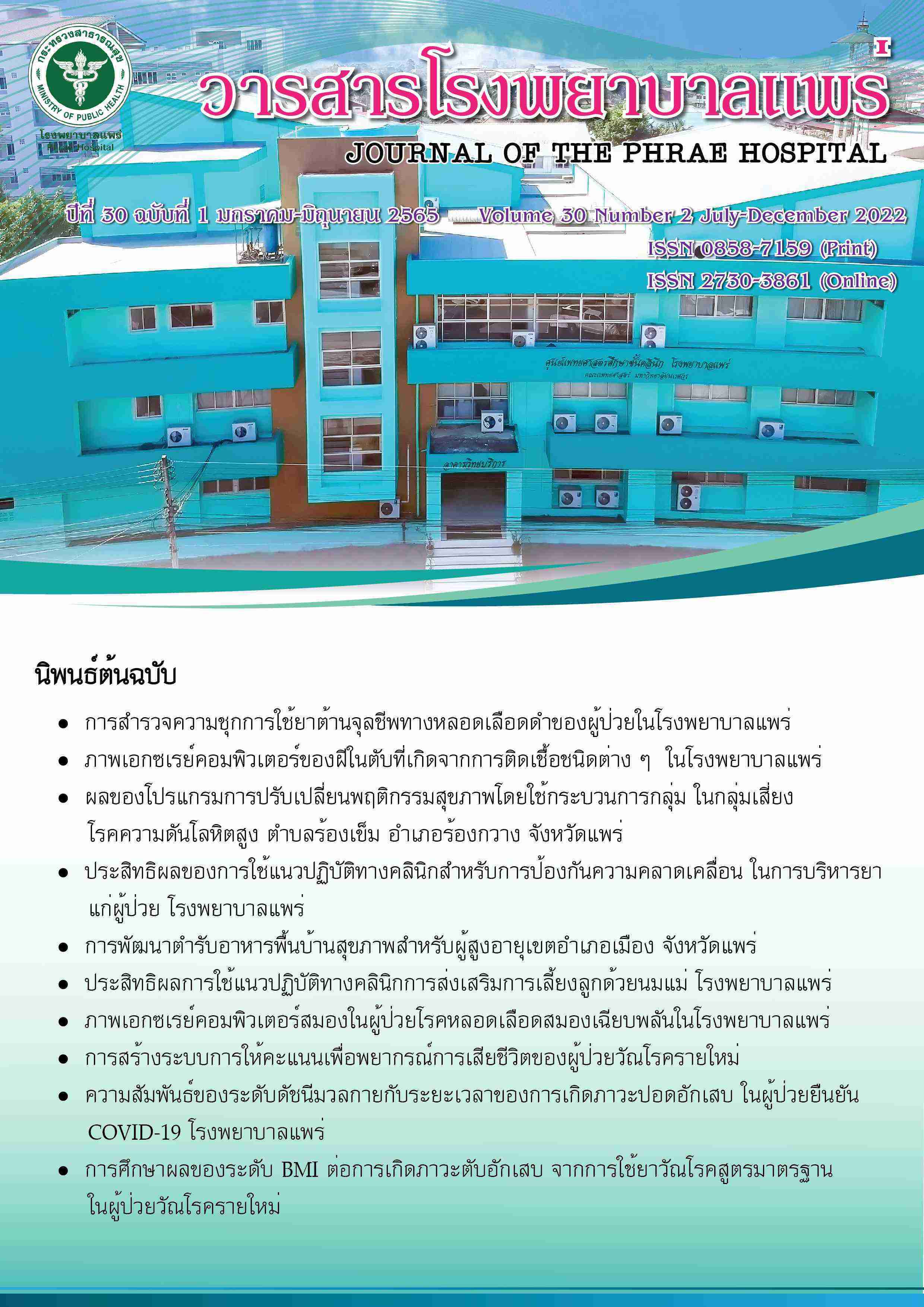A prevalence survey of intravenous antimicrobial use of inpatients at Phrae Hospital
Keywords:
Point Prevalence Survey, Antimicrobial, IntravenousAbstract
Background: The improper prescription of antibiotics is one factor that promotes antibiotics resistance. Access to antimicrobial surveillance data is essential when assessing the pattern and appropriateness of antimicrobial prescription in hospital
Objective: This study aimed to describe the rate of antimicrobial use and pattern of prescriptions in Phrae hospital.
Method: A point prevalence survey on antimicrobial use was conducted on 2nd February 2565. The survey included all inpatient beds who receiving intravenous antibiotics.
Results: The study included 530 patients, 45.28% of whom received intravenous antimicrobial treatment. There was an estimated antimicrobial prescription rate per 1000 population of 452. The intensive care units, the rate of antimicrobial prescription was 87.5%. Cephalosporin was frequently prescribed antimicrobial, Ceftriaxone was prescribed in intensive care units (28.57%), surgical wards (40.78%) and medical wards (32.67%). First generation cephalosporin, cefazolin was prescribed for surgical prophylaxis commonly in Orthopedic wards. The reason for antimicrobial use was empirical treatment of infection, 60.41%, specific treatment 26.67% and surgical prophylaxis 12.92%. Urinary tract infection was the most diagnosis for antimicrobial prescription. Escherichia coli was found the most frequent pathogen in the patient of medical wards (4.03%) and surgical wards (2.41%).
Conclusion: Nearly half of hospitalized patients received antimicrobial. This was comparable with other tertiary care centers. This study provides important baseline information on antimicrobial use in Phrae hospital.
Keywords: Point Prevalence Survey, Antimicrobial, Intravenous
References
สำนักงานคณะกรรมการอาหารและยา. รายงานการบริโภคยาต้านจุลชีพที่ใช้ในมนุษย์และสัตว์ในประเทศไทยของ ปี 2560. นนทบุรี: สำนักงานคณะกรรมการอาหารและยา; 2560.
Thamlikitkul V. Antimicrobial resistance. J Healthe Serv, Res. Policy 2012;6(3):300-5.
Watkins RR, Bonomo RA. Over- view: global and local impact of antibiotic resistance. Infect Dis Clin North Am 2016;30(2):13-22.
Abushaheen MA, Muzaheed, Fatani AJ, Alosaimi M, Mansy W, George M, et al. Antimicrobial resistance, mechanisms and its clinical signifi- cance. Dis Mon 2020;66(6):100971.
Barriere SL. Monotherapy versus combination antimicrobial therapy: a review. Pharmacotherapy 1991;11(2 (Pt 2)):64s-71s.
Centers of Disease Control and Prevention. Public health focus: surveillance, prevention and control of nosocomial infection. MMWR 1992;41:783-7.
สถาบันบำราศนราดูร. คู่มือวินิจฉัยการติดเชื้อในโรงพยาบาล. กรุงเทพฯ: อักษรกราฟฟิคแอนด์ดีไซน์; 2561.
Zarb P, Amadeo B, Muller A, Drapier N, Vankerckhoven V, Davey P, et al. Identification of targets for quality improvement in antimicrobial pres- cribeing: the web-based ESAC Point Prevalence Survey 2009. J Antimi- crob Chemother 2011;66(2):443-9.
Jamaluddin NAH, Periyasamy P, Lau CL, Ponnampalavanar S, Lai PSM, Ramli R, et al. Point Prevalence Survey of Antimicrobial Use in a Malaysian Tertiary Care University Hospital. Antibiotics (Basel) 2021;10(5):531.
Magill SS, O’Leary E, Ray SM, Kainer MA, Evans C, Bamberg WM, et al. Antimicrobial Use in US Hospitals: Comparison of Results From Emerg- ing Infections Program Prevalence Surveys, 2015 and 2011. Clinical Infectious Diseases 2020;72(10):1784-92.
Saleem Z, Hassali MA, Hashmi FK, Godman B, Bhutta OA. A repeated point prevalence survey of antimi- crobial use in specialized cancer care hospital of Pakistan: findings and implications. Hospital Practice 2019;47(3):149-54.
กระทรวงสาธารณสุข. ภูมิทัศน์ของสถานการณ์และการจัดการการดื้อยาต้านจุลชีพ ในประเทศไทย. นนทบุรี: อักษรกราฟฟิคแอนด์ดีไซน์; 2560.
วันดี ขำยัง, สาริณีย์ กฤติยานันต์, วิชัย พานิชสุข. การใช้ยาต้านจุลชีพในผู้ป่วยโรคติดเชื้อในโรงพยาบาลที่โรงพยาบาลราชบุรี [วิทยานิพนธ์ปริญญาเภสัชศาสตร มหาบัณฑิต]. กรุงเทพฯ: จุฬาลงกรณ์มหาวิทยาลัย; 2545.
ทรรศนันทน์ อ่วมประเสริฐ. การสำรวจความชุกของการติดเชื้อในโรงพยาบาลของสถาบันสุขภาพเด็กแห่งชาติมหาราชินี พ.ศ. 2558. วารสารกรมการแพทย์ 2560:42(2):26-31.
พัชนี ทองประเสริฐ. การศึกษาประสิทธิภาพการเฝ้าระวังและการปฏิบัติของพยาบาลในบทบาทด้านการป้องกันและควบคุมการติดเชื้อในโรงพยาบาล โรงพยาบาลสรรพสิทธิประสงค์ อุบลราชธานี [วิทยานิพนธ์ปริญญาวิทยาศาสตรมหาบัณฑิต]. กรุงเทพฯ: มหาวิทยาลัยมหิดล; 2541.
ภาณุมาศ ภูมาศ, ตวงรัตน์ โพธะ, วิษณุ ธรรมลิขิตกุล ตวงรัตน์ โพธะ, อาทร ริ้วไพบูลย์, สุพล ลิมวัฒนานนท์. ผลกระทบด้านสุขภาพและเศรษฐศาสตร์ จากการ ติดเชื้อดื้อยาต้านจุลชีพในประเทศไทย: การศึกษาเบื้องต้น. วารสารวิจัยระบบสาธารณสุข 2555;6(3):352-60.
นิตยา อินทราวัฒนา, มุทิตา วนาภรณ์. โรคติดเชื้อในโรงพยาบาลและสถานการณ์การดื้อยา. วารสารการแพทย์และวิทยาศาสตร์สุขภาพ 2558;22(1):81-92.
Robert J, Péan Y, Varon E, Bru JP, Bedos JP, Bertrand X, et al. Point prevalence survey of antibiotic use in French hospitals in 2009. J. Antimicrob Chemother 2012;67(4):120-6.
National Antimicrobial Resistance Surveillance Center, Thailand: NARST [Internet]. 2020 [cited 2022 Jul 21]. Available from: http://narst.dmsc. moph.go.th/




